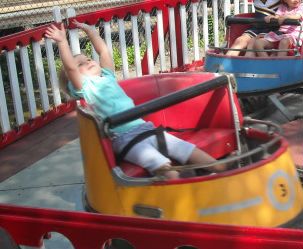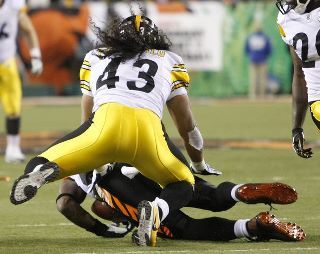Post by misty on Jan 7, 2007 0:54:42 GMT -5
An Ounce of Ketchup
May 8, 2006
The Reading Window
You readers are always encouraged to send in hints on what has worked with your kids - and/or students. This newsletter features some terrific tips that readers have given me permission to share. The first is from a teacher, who is also a grandmother. She writes, Children who are dyslexic should use a plain 3x5 or 4x6 index card with a small area cut out in the center for lines of print to show when reading. Dyslexic children (and adults) have accentuated peripheral vision and limiting the text allows them to read with less difficulty.
I should note that the reading specialist at our elementary school uses this technique with lots of the children in her classes, even those who do not have dyslexia. It's a great way to improve focus and reading speed.
Another Testing Hint!
Here's a brilliant hint to add to your testing arsenal from the same grandmother:
(During testing)...each child receives at least one piece of plain paper for scrap. The paper is most often unlined. Students should, just as they begin to take the test, fold that paper in half, in half again, and in half again. Then for the reading test they can use it as a place holder when reading and jot down relevant points on one section of the folded paper. When they go on to another reading selection, they simply turn the paper over, still folded, to a new section and take notes again. Continue until all sections are used up and ask for another sheet of paper if necessary. The theory is that the brain wants us to fill in any unused white space on that paper, which is why, when it is a complete sheet, all notes are randomly placed on that paper. The blank white field on the paper is also a distraction to the brain. When the paper is folded, the distraction is limited and the brain returns to its work. Students have a limited amount of space to fill in, making them feel successful when they have answered several questions, solved one or two problems or written a few notes in the limited space. Also, when using a new section, there are no distractions from writings made while working in other areas of the test. This is perfectly fine to do, no illegalities for the tester.
Heres an article which lists things that have worked to help the authors son learn to enjoy reading...hes severely dyslexic.
Some of the things listed are:
What Has Worked
While there is no miraculous breakthrough to report when it comes to our son’s willingness to sit down with a book, we have found ways to promote his literacy. Every child is different, but here are some of the strategies that have worked for us:
* Books on tape:
*Reading aloud
*Watch the movie first
*Books with large print
*Seize the moment
All the strategies are fully explained in the article.
unicorn-tiff'smom
The Reading Specialist at Tiffany's school had suggested books on tape and reading aloud as 2 key things to do with Tiffany at home.
They also use the cut out index card method to help children focus on each word they are reading. I used 1 with a few of the children today in the classroom.
May 8, 2006
The Reading Window
You readers are always encouraged to send in hints on what has worked with your kids - and/or students. This newsletter features some terrific tips that readers have given me permission to share. The first is from a teacher, who is also a grandmother. She writes, Children who are dyslexic should use a plain 3x5 or 4x6 index card with a small area cut out in the center for lines of print to show when reading. Dyslexic children (and adults) have accentuated peripheral vision and limiting the text allows them to read with less difficulty.
I should note that the reading specialist at our elementary school uses this technique with lots of the children in her classes, even those who do not have dyslexia. It's a great way to improve focus and reading speed.
Another Testing Hint!
Here's a brilliant hint to add to your testing arsenal from the same grandmother:
(During testing)...each child receives at least one piece of plain paper for scrap. The paper is most often unlined. Students should, just as they begin to take the test, fold that paper in half, in half again, and in half again. Then for the reading test they can use it as a place holder when reading and jot down relevant points on one section of the folded paper. When they go on to another reading selection, they simply turn the paper over, still folded, to a new section and take notes again. Continue until all sections are used up and ask for another sheet of paper if necessary. The theory is that the brain wants us to fill in any unused white space on that paper, which is why, when it is a complete sheet, all notes are randomly placed on that paper. The blank white field on the paper is also a distraction to the brain. When the paper is folded, the distraction is limited and the brain returns to its work. Students have a limited amount of space to fill in, making them feel successful when they have answered several questions, solved one or two problems or written a few notes in the limited space. Also, when using a new section, there are no distractions from writings made while working in other areas of the test. This is perfectly fine to do, no illegalities for the tester.
Heres an article which lists things that have worked to help the authors son learn to enjoy reading...hes severely dyslexic.
Some of the things listed are:
What Has Worked
While there is no miraculous breakthrough to report when it comes to our son’s willingness to sit down with a book, we have found ways to promote his literacy. Every child is different, but here are some of the strategies that have worked for us:
* Books on tape:
*Reading aloud
*Watch the movie first
*Books with large print
*Seize the moment
All the strategies are fully explained in the article.
unicorn-tiff'smom
The Reading Specialist at Tiffany's school had suggested books on tape and reading aloud as 2 key things to do with Tiffany at home.
They also use the cut out index card method to help children focus on each word they are reading. I used 1 with a few of the children today in the classroom.




